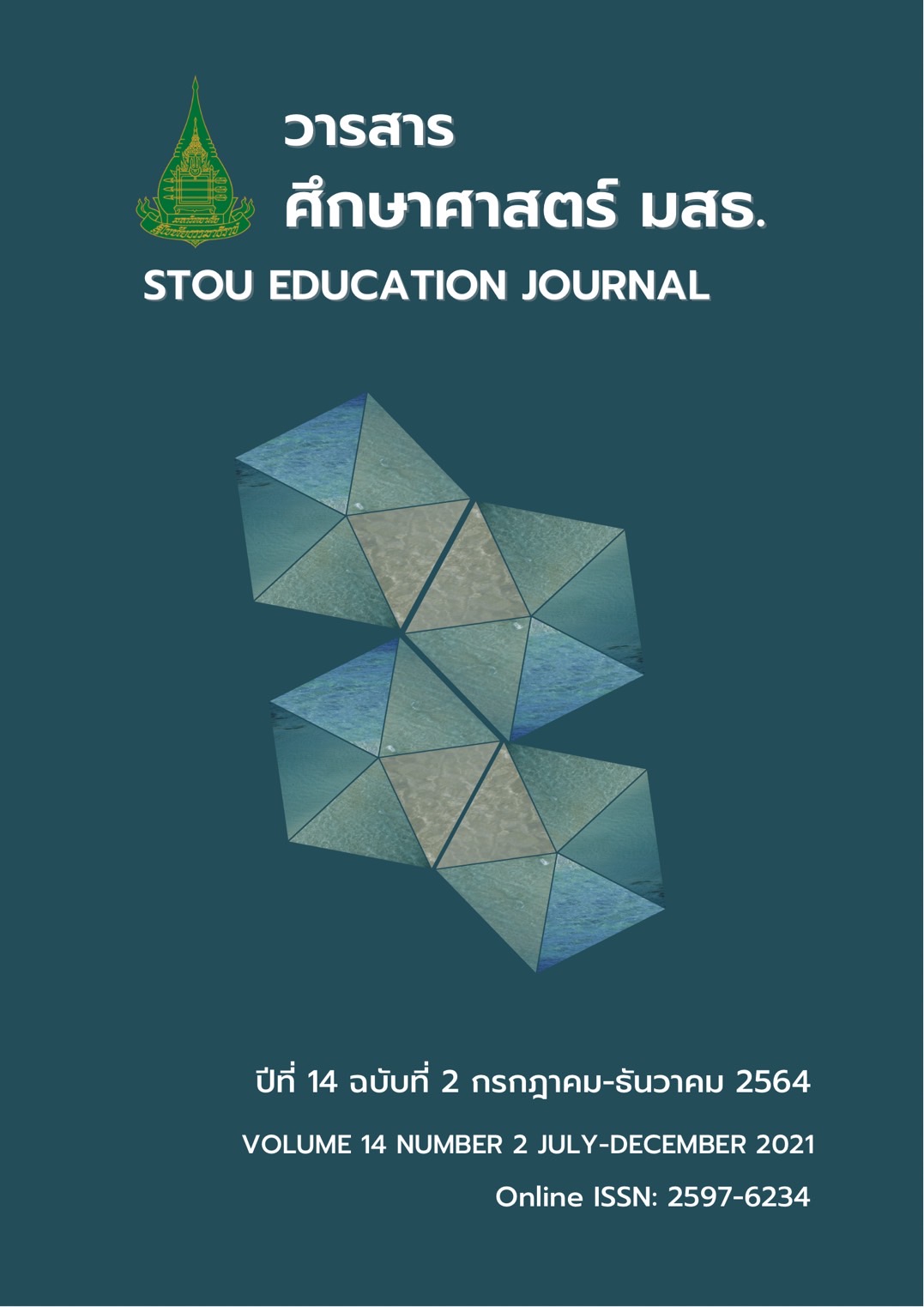A Model of New Normal School Administration to Desirable Educational Quality in Changing Context
Main Article Content
Abstract
The objectives of this research were to: 1) study conceptual frameworks of new normal school administration and desirable educational quality in the changing context; 2) develop a model; 3) experiment the model in school; and 4) verify the structural relationship of the model to the empirical data. A sample of 240 was randomly selected from secondary school administrators. The findings revealed as follows. 1. There were six components of the new normal school administration: 1) proactive policy, 2) flexible organizational structure,
3) new operating system, 4) developing a reversal curriculum, 5) contextual learning management, and 6) interdisciplinary assessment. As for the desirable quality of education in the changing context, there were four components: 1) ability to adapt, 2) achieving goals in disrupted situations, 3) quality of learners in changing contexts, and 4) satisfaction of partners, 2. The model of new normal school administration to desirable quality in a changing context was called PSPCLE model, consisted of three parts 2) guide line of new normal school administration consisted of six components and 3) conditions for success in the new normal school administration consisted of four components 3. The results of the evaluation after the model experiment, it was found that the model was at the very high appropriate level. 4. The result of verification showed that the linear structural relationship of the developed school administration for desirable educational quality in the new normal changing context was consistent with the empirical data in that the Chi-Square /df = 1.485, p-value = 0.07494 GFI = 0.98 RMSEA = 0.036. Recommendations from the research findings were that: school administrators should be change school administration by establishing proactive policy, flexible organizational structure, new operating system, developing a reversal curriculum, contextual learning management, and interdisciplinary assessment.
Article Details
References
พิมฉัตร ฤกษ์รัตน์ระพี. (2562). การพัฒนารูปแบบการฝึกอบรมสมรรถภาพการวิจัยของอาชีวศึกษาด้วยการเสริม พลังอำนาจแบบมีส่วนร่วม. วารสารวิชาการมหาวิทยาลัยอีสเทิร์นเอเซีย ฉบับสังคมศาสตร์และ มนุษยศาสตร์, 10(3), 172-186.
พฤทธิ์ ศิริบรรณพิทักษ์. (2562). การบริหารโรงเรียนของสหภาพยุโรป: Head of the School คือ School Director. ใน รวมบทความบริหารการศึกษากับการพัฒนาการจัดการเรียนรู้สู่การศึกษาในยุคดิจิทัล ชุดที่ 1 รวบรวมโดย จิณณวัตร ปะโคทัง. น. 123-132. อุบลราชธานี: วิทยาการพิมพ์ 1973.
ไพฑูรย์ สินลารัตน์. (2562). การศึกษาไทย: ถึงเวลาต้องคิดใหม่ คิดใหญ่ และทำหน้าที่ทันที. กรุงเทพมหานคร: มหาวิทยาลัยธุรกิจบัณฑิตย์.
ธีระ รุญเจริญ. (2562). ทิศทางการจัดการเรียนรู้สู่การศึกษา 4.0 ในยุคดิจิทัล. ใน รวมบทความการบริหารการศึกษากับการพัฒนาการจัดการเรียนรู้สู่การศึกษาในยุคดิจิทัล ชุดที่ 1. น. 5-9. อุบลราชธานี: วิทยาการพิมพ์ 1973.
วิจารณ์ พานิช. (2562). วิจัยชั้นเรียนเปลี่ยนครู: ฉันจะเป็นครูที่ดีขึ้นได้อย่างไร?. กรุงเทพมหานคร: มูลนิธิสยามกัมมาจล.
วิชัย วงศ์ใหญ่. (2563). New normal ทางการเรียนรู้ (electronic resource). กรุงเทพมหานคร: มหาวิทยาลัยศรีนครินทรวิโรฒ.
วิชัย วงษ์ใหญ่ และ มารุต พัฒผล. (2563). การประเมินการเรียนรู้ใน New normal. กรุงเทพมหานคร: บัณฑิตวิทยาลัยมหาวิทยาลัยศรีนทรวิโรฒ.
วิสุทธิ์ วิจิตรพัชราภรณ์. (2560) . บทบาทเชิงรุกของผู้นำการศึกษาไทย . ใน รวมบทความความเป็นผู้นำทางการศึกษา รวบรวมโดย ไพฑูรย์ สินลารัตน์ และนักรบ หมี้แสน. น. 112-120. กรุงเทพมหานคร: โรงพิมพ์แห่งจุฬาลงกรณ์มหาวิทยาลัย.
วิสุทธิ์ วิจิตรพัชราภรณ์. (2561). การนำนโยบายสู่การปฏิบัติ: แนวความคิด กระบวนการในองค์การทางการศึกษา. กรุงเทพมหานคร: บริษัท วิสต้า อินเตอร์ปริ้นท์ จำกัด.
สุกัญญา แช่มช้อย. (2564). การออกแบบนโยบายการพลิกโฉมระบบการเรียนรู้ที่ตอบสนองการเปลี่ยนแปลงของโลกในอนาคตในปี 2040. กรุงเทพมหานคร: อีเลฟเล่น สตาร์ อินเตอร์เทรด.
สุชัชวีร์ สุวรรณสวัสดิ์. (2562). การบรรยายพิเศษเรื่อง การเปลี่ยนผ่านกระบวนการทางความคิดสู่ D-Court 2020.
มีนาคม 2562 ณ ห้องสมุดศุนย์วิทยบริการศาลยุติธรรมเฉลิมพระเกียรติ.
สุพริศร์ สุวรรณิก. (2564). โลกจะเปลี่ยนไปอย่างไรหลังโควิด-19 จบลง?. สืบค้นจาก https://www.bot.or.th/Thai/ResearchAndPublications/aticle/Page/Areticle_30Mar2020.aspx
สำนักงานเลขาธิการสภาการศึกษา. (2560). แผนการศึกษาแห่งชาติ พ.ศ. 2560– 2579. กรุงเทพมหานคร: พริกหวานกราฟฟิค.
Bawany, (2018). Leading in a disruptive VUCA world. New York: Business Expert Press.
Brightside People Team. (2020). เทคนิคติดจรวดสร้างการเปลี่ยนแปลงวัฒนธรรมองค์กร. สืบค้นจาก https://www.brightsidepeople.com/ เทคนิคติดจรวดสร้างการ/
Hair, J. F., Black W. C., Babin B. J. and Anderson R. E. (2010). Multivariate data analysis. (7th ed). Upper Saddle River, New Jersey: Pearson Education, Inc.
Keeves, J.P. (1997). Models and model building. In Keeves, J.P. (ed.). Educational research, methodology and measurement: An International Handbook. (2nd ed). Oxford : Peraman Press.
Pacheco, J.A. (2020). The “new normal” in education. Research Centre on Education (CIEd), Institute of Education, University of Minho, Braga Campus de Gualtar, Portugal.
Pinar, W. F. (2019). Moving images of eternity: George Grant’s critique of time, teaching, and technology. Ottawa: The University of Ottawa Press.
Quilter-Pinner, H. and Ambrose, A. (2020). The new normal: The future of education after COVID-19.Institute for Public Policy Research. United Kingdom: London.
Shepherd, A.C. (2019). An analysis of factors which influence high school administrators’ readiness and confidence to provide digital instructional leadership. Retrieved from https://files.eric.ed.gov/ fulltext/EJ1218848.pdf


